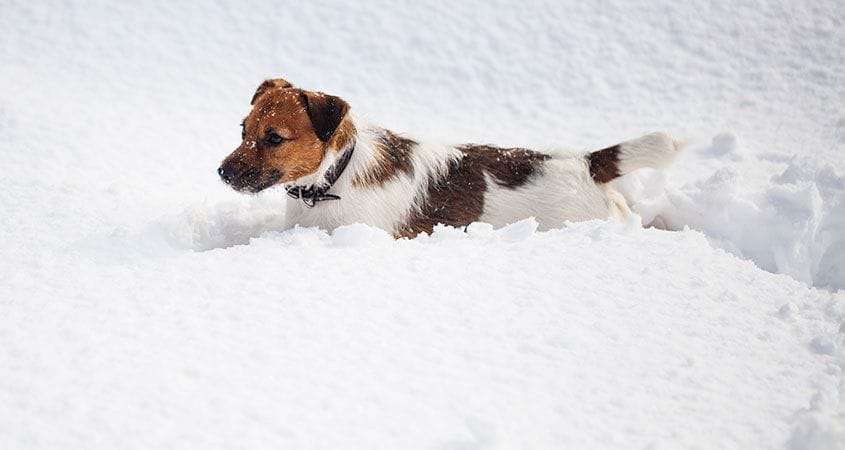Recently, we sat down with veterinarian Dr. Henry Cerny to discuss some of the common myths about dogs and cold winter weather. Here are the misconceptions and the facts you need to know as temperatures drop.
Myth 1: Salt doesn’t hurt dog’s paws
Lots of fans say their dogs’ paws get burned by the salt used to melt snow on the ground. They suggest putting Vaseline on paws so the cushions don’t get burned by the salt on the road, or the cold of the snow. What do you think?
Dr. Cerny: There are a variety of products used to melt snow and ice. Some compounds can damage the concrete and leave it pitted, so you can imagine what it may do to a dog’s paws.
There are several products on the market that are labeled as pet safe. I have no recommendations of one over the other. Vaseline is generally safe but can stick to things like carpet. Rinsing your dog’s paws after a walk where snow and ice melting products have been applied is a safe and effective means of protecting your dog’s feet. You can also use baby wipes.
Myth 2: Dog boots are just a fashion fad
Why and when can dogs benefit from wearing boots? How can you tell if they fit properly?
Dr. Cerny: There are quite a variety of styles and quality of boots designed for dogs. Boots can help protect a dog’s feet from rough, chemically treated, cold and hot surfaces. The inside of the boots should be kept clean and dry, and they should not be left on for an extended period of time. Finding the right fit may require some trial and error. Some boots require frequent adjustment because they slip.
Myth 3: If it’s too cold outside for humans, it’s too cold for dogs
How cold is too cold to leave a dog outside? Is there any difference across various breeds?
Dr. Cerny: Many dogs can handle much colder conditions than humans, but nothing beats common sense. A sled dog is used to extreme cold while a Chihuahua probably is not. Thick coated breeds can handle much colder weather than short haired breeds. If a dog lives outside it is important to provide shelter from the wind and snow.
Myth 4: My dog has fur, she doesn’t need to wear a coat
What are the recommendations? What are things to look for in a dog coat? Are electrically heated pet beds or a dog house with a heated floor also recommended? Do dogs need blankets?
Dr. Cerny: Some dogs, especially short haired breeds, can benefit from a coat during cold weather. Make sure the coat adequately covers the body and does not obstruct movement. Any electric heating bed or pad always carries the risk of burns, so follow the manufacturer’s guidelines. Blankets can add another layer of insulation during the cold weather.
Myth 5: Dog’s watery eyes can’t be dry
What are some symptoms of dry eyes in dogs? What are some good eye care tips during winter? Do dogs need eye wash during harsh, cold weather?
Dr. Cerny: Common signs of dry eye (keratoconjunctivitis sicca) in dogs include conjunctivitis, mucoid discharge, and irritated painful eyes. Without prompt treatment the surface of the eye (cornea) can become scarred and affect vision.
During the colder months the air is much dryer and some breeds are predisposed to eye irritation. Products such as artificial tears can be used to help moisten the eyes. Some eye conditions can become serious quickly, so consult your veterinarian to determine the cause and best treatment for eye problems.
Myth 6: Some dog breeds are immune to the harsh effects of winter
Do all Huskies, German shepherds, and St. Bernards want to be outside during winter? Are some dog breeds immune to the harsh effects of winter?
Dr. Cerny: Some dog breeds (especially thick coated breeds) seem to enjoy the cold weather. It is important to observe how your dog acts when outside in the cold. Signs such as shivering and wanting to come back inside immediately indicate that your dog does not appreciate the cold outside.
Myth 7: It’s never too cold to exercise outdoors
What do you recommend for exercising dogs when it is too cold for them to be outside?
Dr. Cerny: Inside exercises range from supervised treadmill walks to walking or running up and down the stairs and creating mini obstacle courses with household objects, such as pillows. When it’s cold outside, this provides a great opportunity to work on basic obedience in the comfort of your own home.
Myth 8: Ear infection is a summer ill
Low temperatures and higher moisture can increase the incidence of ear infection in dogs. How do you treat it?
Answer: Ear infections can occur year-round and may be quite advanced before you notice. Routine use of an ear wash in most cases can be beneficial in the treatment and prevention of ear infections. Some ear infections require prescription strength medications, so if your dog has an ear problem have it checked out by your veterinarian.
Dr. Cerny, DVM, MS, is a veterinarian at Yankee Hill Veterinary Hospital in Lincoln, Nebraska.
Do you provide special care for your dog during the winter? Tell us all that you do in the comments.











